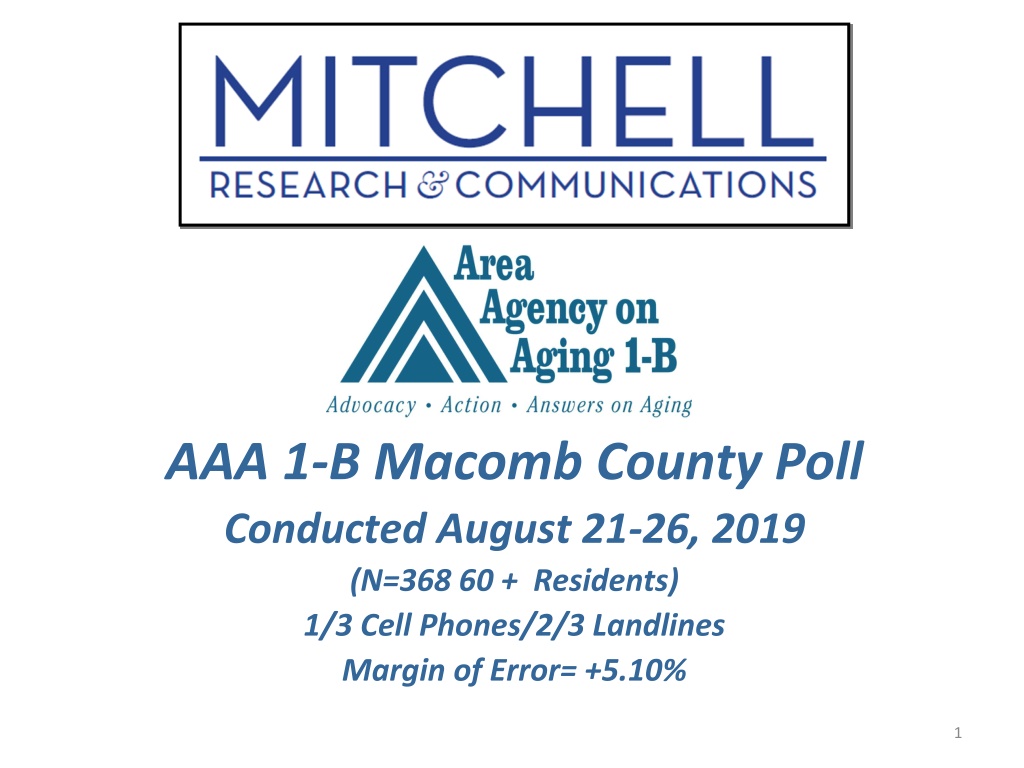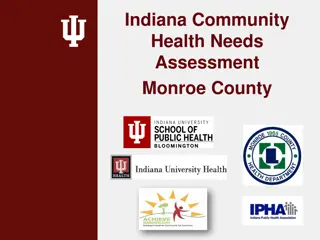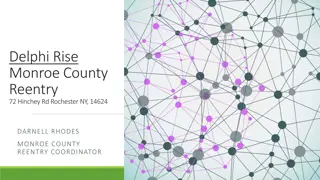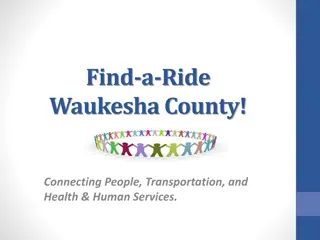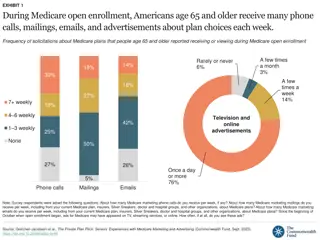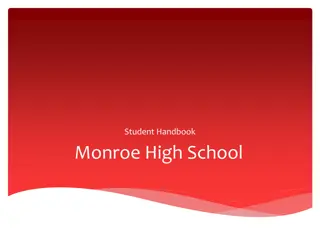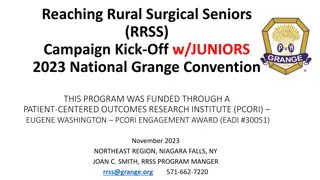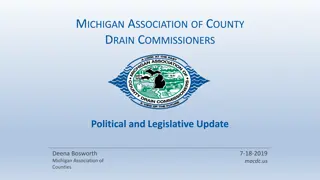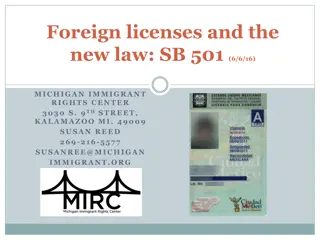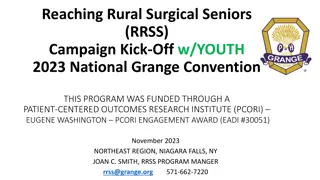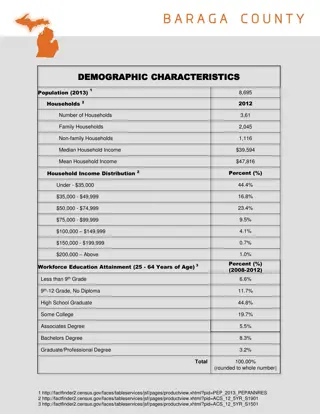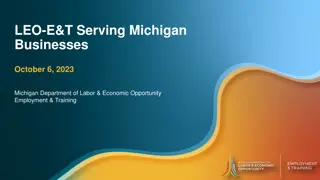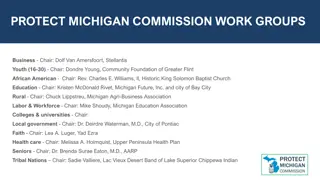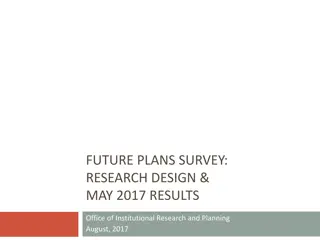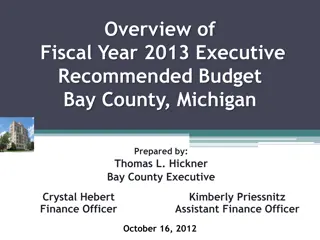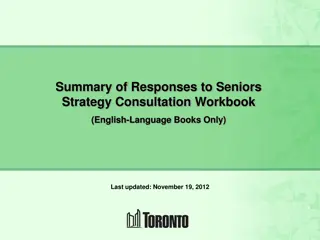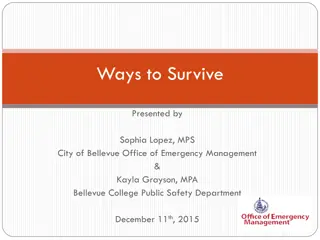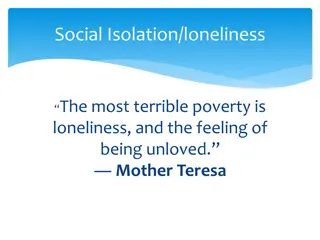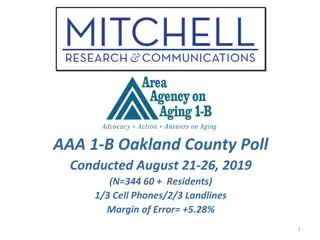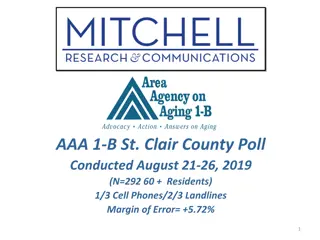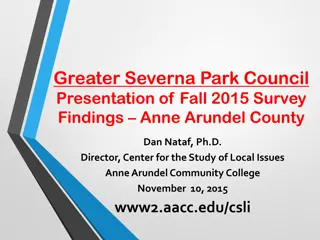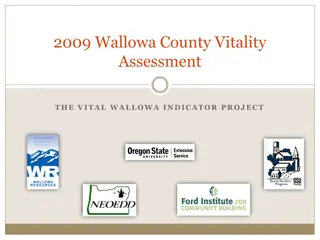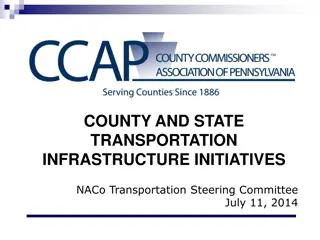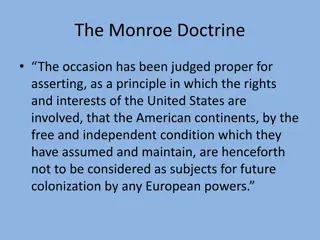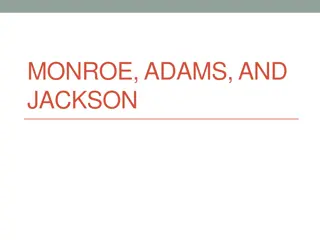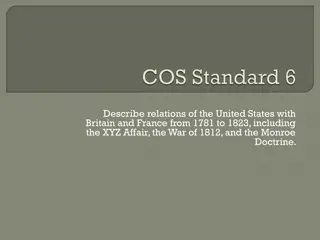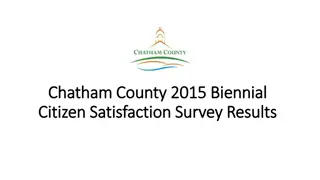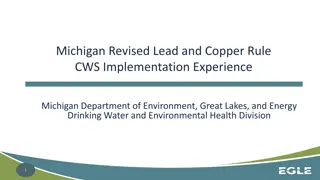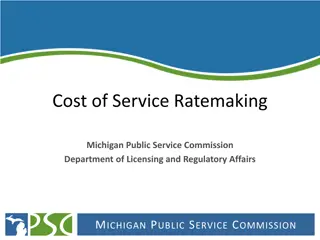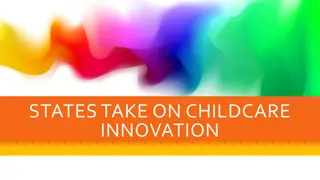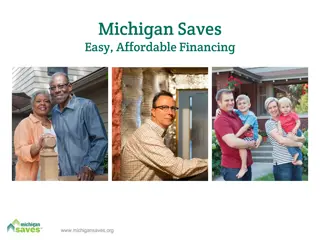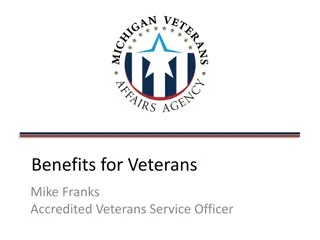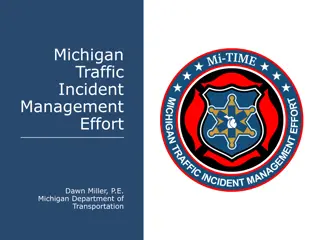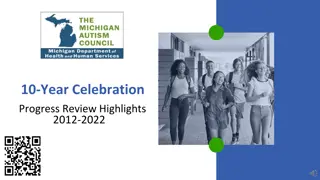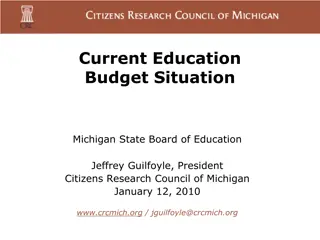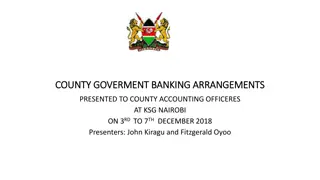Research Findings on Issues Impacting Seniors in Monroe County, Michigan
Research conducted by Mitchell Research & Communications in Macomb County, Michigan aimed to determine attitudes and opinions on various issues affecting residents over the age of 60. The study focused on conditions in their homes, transportation issues, health concerns, knowledge of benefits, social involvement, and more. Results indicated top concerns such as lack of handrails or grab bars and homes needing minor repairs. Rural residents highlighted specific issues like clutter and smoke detector needs.
Download Presentation

Please find below an Image/Link to download the presentation.
The content on the website is provided AS IS for your information and personal use only. It may not be sold, licensed, or shared on other websites without obtaining consent from the author. Download presentation by click this link. If you encounter any issues during the download, it is possible that the publisher has removed the file from their server.
E N D
Presentation Transcript
AAA 1-B Macomb County Poll Conducted August 21-26, 2019 (N=368 60 + Residents) 1/3 Cell Phones/2/3 Landlines Margin of Error= +5.10% 1
Goals and Objectives of the Research The goals were to determine the following: Determine attitudes and opinions on a wide variety of issues impacting citizens over the age of 60 who live in Monroe County, Michigan. Those issues include: (1)Conditions in their homes (2) Transportation issues (3) Physical and mental health issues (10) Knowledge of benefits (4) Addictions (5) Social involvement (6) Treatment by others (7) Hardships (8) Serious Challenges (9) Unmet Needs (11) Healthcare resources (12) Income/Financial Info 2
Methodology Mitchell Research & Communications conducted a quantitative study (telephone survey) to determine attitudes and opinions on a wide variety of issues facing 60+ residents of Livingston County. The telephone survey of N=368 Macomb County residents over the age of 60 was conducted August 21-26, 2019 and has a MoE of + or 5.10% at the 95% level of confidence. A telephone list containing landline and cellphone numbers for all 60+ residents in Monroe County was used. Filter questions were asked so that only respondents who were 60+ and residents of Monroe County were surveyed. Any calls to non-residents or those younger than 60 were terminated. Sixty-seven percent of all calls were completed to landlines and 33% to cell phones. The gender split was 52% female, 48% male. 3
Gender 60% 50% 50% 50% 40% 30% 20% 10% 0% Male Female 4 4
Age 25% 23% 22% 21% 20% 20% 14% 15% 10% 5% 0% 60-64 65-69 70-74 75-79 80+ 5 5 5
Area 100.0% 91.0% 90.0% 80.0% 70.0% 60.0% 50.0% 40.0% 30.0% 20.0% 9.0% 10.0% 0.0% Rural Urban 6
Home Condition Concerns The top two concerns are not enough handrails or grab bars (13.6%) (30,774 people) and home in need of minor repairs (11.1%) (25,117 people) 4
Home Condition Concerns 32.6% 35.0% 30.0% 25.0% 20.0% 13.6% 11.1% 15.0% 8.7% 7.6% 10.0% 4.1% 3.5% 2.4% 5.0% 0.0% 8
Conclusions Home Condition Concerns The top two concerns are not enough handrails or grab bars (13.6%) (30,774) and home in need of minor repairs (11.1%) (25,117). In terms of not enough handrails or grab bars, 21.9% (4,460) of rural residents cited this as a concern The next grouping of issues would be too cluttered (8.7%) (19,687), and need smoke detector (7.6%) (17,198). Those making less than $25K cited need smoke detector nearly twice as frequently as the average (14.0%) (11,088)
Conclusions Home Condition Concerns The final three would be poor water quality (4.1%) (9,278), need a ramp (3.5%) (7,920) and presence of mold (2.4%) (5,431). Poor water quality was cited by 9.4% (1,914) of those in rural areas In general, there are no major differences between the specific groups (age, income, area) tested. No home safety concerns were listed by nearly one third (32.6%) (73,768) This is higher among those making less than $25K (41.9%) (33,184) and lower among those making above $25K (27.6%) (40,595)
Transportation Issues Transportation to Doctors Appointment 83.2% 80.0% 90.0% 70.0% 60.0% 50.0% 40.0% 30.0% 20.0% 11.4% 10.0% 3.0% 0.8% 0.8% 0.8% 0.0% 11
Transportation Issues Missed a Medical Appointment in Last 12 Months Due to Transportation 3.3% Almost 7,500 seniors 12
Conclusions Transportation Concerns Only 6.5% (14,708) of respondents said they have trouble getting to the places they need to go. When respondents need to see a doctor, 83.2% (188,267) drive themselves. As one would expect, the percentage is lower among those making below $25,000 (72.9%) (57,736) and higher among those making more than $25,000 (88.7%) (130,464). Another 11.4% (25,796) get a ride from their spouse or family. This number is significantly higher among those making below $25,000 (17.1%) (13,543) compared to those making more than $25,000 (8.4%) (12,355).
Health Concerns Almost one third (29.6%) (66,980) of all respondents do not have any health concerns 4
Health Concerns 35.0% 29.6% 30.0% 23.6% 23.1% 25.0% 20.4% 17.7% 20.0% 17.4% 16.3% 15.0% 10.0% 5.0% 0.0% 15
Conclusions Health Concerns Almost one third (29.6%) (66,980) of all respondents do not have any health concerns. This is very consistent across all demographics. When given a list of six potential health concerns, five had about the same number of respondents, indicating that it was one of their concerns. Those five were: Not being able to do the things I enjoy (23.6%) (53,403) Coping with pain (23.1%) (52,271) Losing my independence (20.4%) (46,162) Paying for health care (17.7%) (40,052) Fear of falling (16.3%) (36,884) Another 17.4% (39,373) reported that they had other health concerns
Conclusions Health Concerns Those making less than $25,000 per year had a higher percentage of respondents citing not being able to do the things I enjoy, coping with pain, fear of falling, and losing my independence A lower percentage of those living in rural areas cited paying for health care (6.3%) (1,283) and a higher percentage cited no health concerns (37.5%) (7,637) A higher percentage of those 75+ cited paying for health care (24.7%) (20,121) Almost all of the respondents (96.7%) (218,816) have a regular primary care physician.
Missed Doctor and Dentist Appointments When They Thought They Should Go 16.0% 13.9% 14.0% 12.0% 10.0% 7.9% Doctor Dentist 8.0% 6.0% 4.0% 2.0% 0.0% Yes 18
Conclusions Missed Appointments Seven and nine tenths percent (7.9%) (17,876) of the respondents said that there have been times in the last twelve months where they thought they should see a doctor but did not. Again, the percentage of respondents who did not go to a dentist when they thought they should (13.9%) (31,453) is slightly higher than the 7.9% (17,876) that did not see a doctor. The percentage is much higher among those making below $25,000 (20.2%) (15,998) and lower among those making more than $25,000 (10.5%) (15,444).
Conclusions Missed Appointments Reasons cited include (N=29): I was too afraid (31.0%) (5,612) I could not afford it, not covered by insurance and other were all (20.7%) (3,747) No way of getting there and could not get in as patient were both (17.2%) (3,114) I was too sick (13.8%) (2,498)
Quality of Health Eight in ten (79.1%) (178,990) of respondents said in general their health is very good (28.0%) (63,359) or good (51.1%) (115,631). Another 17.1% (38,694) said it is fair while just 3.8% (8,599) said it was poor. 4
Quality of Health - General Health 60.0% 51.1% 50.0% 40.0% 28.0% Total Rural 30.0% 25.0% 18.8% 20.0% 17.1% 10.0% 3.8% 0.0% Very Good Good Fair Poor 22
Quality of Life - Causes of Painful Feelings 35.3% 35.0% 40.0% 30.0% 23.1%20.1%19.0%18.5% 25.0% 20.0% 15.0% 11.4%10.3%9.0% 8.7% 10.0% 5.7% 5.4% 2.7% 5.0% 0.0% 23
Quality of Life Almost three out of four respondents (72.8%) (164,734) say that during the past 30 days they have had no difficult or painful feelings such as stress, grief, worry, anger, or loneliness Over one third (35.3%) (79,878) say that from a list of things that might cause them pain, the inability to do things I used to is mentioned most often. This rises to 47.5% (37,620) among those making under $25K per year This falls to 29.7% (43,684) among those making more than $25K Loss of independence is citied by 11.4% (25,796) of respondents. This is mentioned by a much higher percentage of those living in rural areas (21.9%) (4,460)
Addictions 25.0% 23.1% 20.0% 15.8% 15.0% 10.0% 7.9% 7.3% 5.2% 5.0% 1.6% 1.4% 0.3% 0.0% 0.0% 25
Addictions Working To Quit 80.0% 66.7% 70.0% 60.0% 50.0% 40.0% 33.3% 30.0% 20.0% 10.0% 0.0% Yes No 26
Addictions Why Not Working To Quit 80.0% 75.0% 70.0% 60.0% 50.0% 40.0% 30.0% 20.0% 11.4% 5.7% 10.0% 3.4% 3.4% 1.1% 0.0% Not Ready Tried, Can't Afford It Don't Know of Local Programs Programs Are For Young People, Not Seniors Can't Get To Any Programs Unsuccessful 27
Conclusions Addictions Among the more serious addictions, alcohol by 1.6% (3,621), opioids/narcotic pain medication were cited by 1.4% (3,168), marijuana by 0.3% (679), and illegal drugs by 0.0% (0) (N=88) When those who said they were not actively trying to quit were asked why not, the most common answer was not ready to quit (75.0%) (40,731). This was much higher among those making below $25K (68.8%) (13,077) and higher among those in rural areas (100%) (20,365) Among those who cannot afford to quit, those 75+ were a much higher portion (12.5%) (2,444)
Social Involvement Friends, Neighbors, and Relatives 80.0% 75.0% 70.0% 60.0% 50.0% Total Rural 40.0% 28.1% 30.0% 21.5% 20.0% 10.0% 3.5% 0.0% Not Enough About Enough Too Much 29
Social Involvement Social Activity 80.0% 69.3% 70.0% 63.6% 60.5% 60.0% 50.0% Total 75+ <25K Rural 40.0% 34.1% 30.0% 25.8% 20.0% 10.0% 4.9% 0.0% Not Enough About Enough Too Much 30
Social Involvement Would Participate In 66.3% 53.5% 53.5% 70.00% 60.00% 46.5% 50.00% 40.00% 31.4% 30.00% 23.3% 19.8% 20.00% 10.00% 0.00% 31
Social Involvement What Prevents You From Participating 25.0% 20.4% 20.0% 16.0% 15.0% 13.0% 11.7% 9.5% 9.0% 10.0% 5.0% 0.0% Don't Know of Such Programs Prefer To Be With Younger People Cannot Afford It Too Don't Want To Be With People In The Programs Don't Have A Way To Get There Sick/Disabled to Participate 32
Elder Abuse When asked about whether or not they are being treated badly, at least 97% (219,495) say they are not. There is a higher incidence of people making under $25K a year and those over the age of 75 indicating they are being treated badly. Almost no rural residents report being treated badly on any of the issues discussed. There are three examples: 2.2% (4,978) of all respondents say someone hurts me, but that percentage is 4.5% (3,666) of those over the age of 75. 2.2% (4,978) say someone is supposed to help me with other things but is not doing it, but the incidence of respondents making less than $25k a year (3.9%) (3,089) is higher while those making above $25K (1.3%) (1,912) is lower. 1.6% (3,621) say someone touches me without my consent, but the percentage goes to 3.1% (2,455) of those making under $25K.
Greatest Hardship Faced by Others 30.0% 25.4% 25.0% 18.8% 20.0% 16.7% 13.6% 15.0% 8.0% 10.0% 5.6% 4.9% 4.9% 5.0% 2.1% 0.0% 34
Serious Challenges 28.0% 30.0% 25.0% 20.0% 17.1%16.3%15.2%13.0%11.4%11.4%9.8%9.2%7.9%7.3%6.5%4.6% 15.0% 10.0% 5.0% 0.0% 4
Conclusions Biggest Unmet Need Challenges The following is the list of the biggest unmet need faced by older adults cited by respondents: Don t Know (27.2%) (61,549) 60-74 (34.1) (49,384) 75+ (17.5%) (14,256) Rural residents (21.9%) (49,556) Home care assistance (20.4%) (46,162) Home maintenance assistance (12.8%) (34,084) Door-to-door transportation (11.4%) (25,796) Other (8.7%) (19,687) Information about senior services (7.6%) (17,198) Affordable housing (6.8%) (15,387) Food or nutritious food options (5.2%) (11,767)
Receiving All Benefits Eligible For 90.0% 81.1% 80.0% 70.0% 60.0% 50.0% 40.0% 30.0% 20.0% 12.0% 6.2% 10.0% 0.0% Yes No Not Sure 4
Conclusions Need Assistance or Information Ranked in order from most to least mentioned, the following are the list of services (N=70): Medicare premium payment assistance (30.0%) (12,898) Property tax relief (27.1%) (11,651) Free cell phone (22.9%) (9,846) Tax preparation/filing assistance (20.0%) (8,599) Medicare/health insurance counseling (20.0%) (8,599) Veterans benefits (18.6%) (7,997) SNAP/Food stamps/Bridge card (18.6%) (7,997) Home energy weatherization (17.1%) (7,352) Food pantry delivery (15.7%) (6,750) Job training or employment assistance (10.0%) (4,299) Reverse mortgage counseling (7.1%) (3,053) Medicine discounts (47.1%) (20,250) 4
Conclusions Information About Aging and Resources Ranked in order from most to least mentioned, the following are the list of services: Friends and family (70.1%) (158,624) Doctor or healthcare provider (62.2%) (140,784) Mail delivered to my home (47.0%) (106,353) Internet search (38.9%) (88,024) Newspapers (36.4%) (82,367) TV (33.4%) (75,579) Senior centers (33.2%) (75,126) Magazines (30.7%) (69,469) Library (30.2%) (68,337) Service agency such as Area Agency on Aging (29.3%) (66,301) Radio (25.8%) (58,381) Flyers, posters, or billboards (23.6%) (53,403) Social media (Facebook, Twitter, Pinterest, etc. (20.9% ) (47,293) 4
Total Combined Income 70.0% 64.9% 60.0% 50.0% 40.0% 35.1% 30.0% 20.0% 10.0% 0.0% At or Below $25,365 Above $25,365 4
Personal Debt Excluding Home, Auto 80.00% 72.3% 70.00% 60.00% 50.00% 40.00% 30.00% 20.00% 9.0% 8.4% 10.00% 6.0% 4.3% 0.00% No Debt Less than $1,000 Between $1,000 and $5,000 Between $5,000 and $10,000 More Than $10,000 4
Trouble Paying Bills 70.0% 58.2% 60.0% 50.0% 40.0% 34.5% 30.0% 20.0% 7.3% 10.0% 0.0% Comfortably Pay Bills Can Afford Bills If Careful Have Trouble Paying Bills 4
Conclusions Trouble Paying Bills Well over half of respondents (58.2%) (131,697) can comfortably afford to pay [their] bills with money left over. This is lower among those 75+ (53.2%) (42,605) and those making under $25K (37.2%) (29,462). It is higher, as you would expect, with those making $25K or more (69.5%) (102,223) About one third (34.5%) (78,068) can afford to pay [their] bills if [they] are careful about spending. This is higher with those making less than $25K (52.7%) (41,738). Seven point three percent (7.3%) (16,519) have trouble paying bills not matter how careful. This climbs to 12.5% (28,285) of those living in rural areas 4
Conclusions Personal Debt Almost three-fourths of the respondents (72.3%) (163,603) have no debt. By age there is a difference where 78.5% (113,684) of those under 75 have no debt compared to 63.6% (51,810) of those over 75. Nine percent (9.0%) (20,365) of respondents have more than $10,000 in debt This percentage is much lower among those making below $25K (3.9%) (3,089) 4
Behind On Payment 12.0% 10.8% 10.8% 10.0% 8.0% 6.9% 5.9% 6.0% 4.0% 2.9% 2.9% 2.0% 0.0% Credit Cards Medical Bills Property Taxes Rent Mortgage Utilities 4
Conclusions Behind On Payment N=103 About one in ten respondents (10.8%) (6,843) are behind on credit card bills This is higher with those making less than $25K (13.3%) () This is lower among those in rural areas (0.0%) (0) About one in ten respondents (10.8%) (6,843) are behind on medical bills This is significantly higher with those making less than $25K (16.7%) (3,703) and among those in rural areas (22.2%) (1,266) Two point nine percent (2.9%) (1,837) are behind on rent Only five point nine percent (5.9%) (3,738) are behind on mortgage This rises to 10.0% (2,218) among those who make less than $25K 4
Thank You Steve Mitchell Mitchell Research & Communications, Inc. 314 Evergreen Suite B, East Lansing, MI 48823 steve@mitchellresearch.net Office: 517-351-4111 Cell: 248-891-2414 6/10/2019 47
